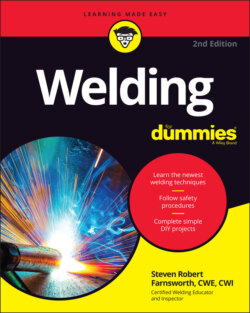Читать книгу Welding For Dummies - Steven Robert Farnsworth - Страница 34
Cleaning steel with mechanical methods
ОглавлениеWhen you clean your steel mechanically, you clean the surface by scraping, brushing, or grinding. I usually clean pieces of steel by hand (without power tools) only when the pieces are very small because power tools are just faster otherwise. If you opt to clean steel by hand, I recommend using a very sturdy wire brush. (Check out Chapter 4 for information on wire brushes and other basic tools you need for welding.)
When cleaning a metal before welding, make sure that the metal in your wire brush or the metal on the attachment you plan to use on your power tool is the same as the metal you’re going to weld. For example, if you’re going to be cleaning a piece of steel, make sure you use a steel wire brush or grinder, not one made of brass or another metal. Otherwise, you run the risk of contaminating the metal with another metal. The exception? It’s okay to use a stainless steel wire brush on aluminum.
Tools powered by electricity or pressurized air have become the standard for cleaning steel in many welding shops, especially for shops that weld large pieces. The most common power tools used for cleaning steel are angle grinders, shown in Figure 2-2. An angle grinder in use is depicted in Figure 2-3.
FIGURE 2-2: A typical angle grinder.
You may think that you can ease up a little on your safety precautions when you’re cleaning a piece of metal but not yet welding it, but don’t be fooled. You can be injured during the cleaning process, particularly if you’re using power tools to clean the metal. Head to Chapter 3 for the lowdown on safety.
